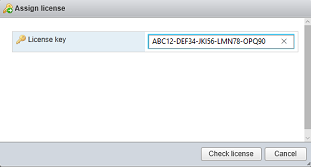

- #ACTIVATE VMWARE ESXI 6.5 LICENSE LICENSE KEY#
- #ACTIVATE VMWARE ESXI 6.5 LICENSE LICENSE#
Do the same for ESXi Host in Hosts Tab if you want to assign License to ESXi Host. Under Assets Tab > Go to vCenter Server Systems (To Assign License to Virtual Center).Go to Licenses Option and and Click on Manage Your Assets under Getting Started tab.Step#2 - Assign License to Virtual Center Now let's move to Step#2 to Assign Licenses. Label the license keys as per your convinient.Enter the vSphere 6.x Standard license key(For ESXi), and click Next.
#ACTIVATE VMWARE ESXI 6.5 LICENSE LICENSE KEY#
Enter the vCenter Server 6.x Standard license key and press Enter to add a new line.Click on + icon to Create New Licenses.Click on Manage your Licenses in Getting Started Tab or Go to Licenses Tab.Go to Home > Click on Licenses under Administration Tab.On top of console, you can see the note saying that licenses in our inventory either expired or not available.Here we have logged in thrugh Web Client. Login to Virtual Center using Web or vSphere Client.Click Assign license to save your changes. Click Assign license, enter a license key in the form XXXXX-XXXXX-XXXXX-XXXXX-XXXXX, and click Check license. Manage License Key for Virtual Center Server:- Step#1 - Add License Key to Virtual Center Procedure Click Manage in the VMware Host Client inventory and click Licensing. Step#2 Assign License to Virtual Center.Step#1 Add License Key to Virtual Center.Please note the same we can do for ESXi Hosts. VMware vSphere 6 Essentials: Small Business EditionsĪs separate editions for small businesses, VMWare offers VMware vSphere 6 Essentials editions.Two Steps to Manage this Licensing for vCenter. When purchasing any of the licenses described above, you also have to buy a vCenter Server Standard license. VSphere with Operations Management Enterprise – in addition to these options, Standard and Enterprise editions offer means of automatic analysis, resource and performance management. VM Encryption − encryption of virtual machine files and vMotion traffic using AES-NI.
 vGPU – an opportunity to share a graphic adapter (GPU) by several VMs. Cross-VC vMotion – migration of VMs between vCenter servers. Host Profiles and Auto Deploy - host profiles and automatic deployment. Single Root I/O Virtualization (SR-IOV) – virtualization of a single PCIe device into several virtual devices. I/O Controls (Storage and Network) – access prioritization due to continuous I/O workload monitoring. Storage DRS – automatic balancing of disk resource workload. Distributed Switch – centralized management of the network configuration. Reliable Memory – optimal placement of VMkernel blocks in the memory. Distributed Power Management – optimization of power consumption due to switching off idle hosts. Distributed Resource Scheduler – balancing the workload between hosts. In addition to Standard features, vSphere Enterprise edition offers the following options: APIs for Array Integration, Multipathing – API storage interfaces to integrate arrays and manage alternative paths. Multi-VC Content Library – centralized management of VM templates, vApp, IOS and scripts. APIs for Storage Awareness (VASA) – vCenter and disk array integration. Storage-Policy Management (SPBM) – an automatic storage management. Virtual Volumes ( VVOLs) – a virtualization of SAN and NAS storage devices. VM Data Replication – an optimized data replication using WAN. Storage vMotion – an online migration of virtual disk files between storage devices. vMotion, Cross-Switch vMotion – an online migration of VMs between servers or virtual switches. Fault Tolerance – provides continuous VM (app) availability in case of hardware failures. High Availability – reduces downtime due to automatic VM restart. VSphere Standard offers the following features: Let’s briefly describe the most interesting features available in different editions: I/O Controls (Network and Storage) and SR-IOV Virtual Volumes and Storage-Policy BasedManagementĭistributed Resource Scheduler (DRS) and Distributed Power Management (DPM) High Availability (HA) and Fault Tolerance(FT)ĭata Protection (VDP) and VM Data Replication VMotion, Storage vMotion and Cross-Switch vMotion
vGPU – an opportunity to share a graphic adapter (GPU) by several VMs. Cross-VC vMotion – migration of VMs between vCenter servers. Host Profiles and Auto Deploy - host profiles and automatic deployment. Single Root I/O Virtualization (SR-IOV) – virtualization of a single PCIe device into several virtual devices. I/O Controls (Storage and Network) – access prioritization due to continuous I/O workload monitoring. Storage DRS – automatic balancing of disk resource workload. Distributed Switch – centralized management of the network configuration. Reliable Memory – optimal placement of VMkernel blocks in the memory. Distributed Power Management – optimization of power consumption due to switching off idle hosts. Distributed Resource Scheduler – balancing the workload between hosts. In addition to Standard features, vSphere Enterprise edition offers the following options: APIs for Array Integration, Multipathing – API storage interfaces to integrate arrays and manage alternative paths. Multi-VC Content Library – centralized management of VM templates, vApp, IOS and scripts. APIs for Storage Awareness (VASA) – vCenter and disk array integration. Storage-Policy Management (SPBM) – an automatic storage management. Virtual Volumes ( VVOLs) – a virtualization of SAN and NAS storage devices. VM Data Replication – an optimized data replication using WAN. Storage vMotion – an online migration of virtual disk files between storage devices. vMotion, Cross-Switch vMotion – an online migration of VMs between servers or virtual switches. Fault Tolerance – provides continuous VM (app) availability in case of hardware failures. High Availability – reduces downtime due to automatic VM restart. VSphere Standard offers the following features: Let’s briefly describe the most interesting features available in different editions: I/O Controls (Network and Storage) and SR-IOV Virtual Volumes and Storage-Policy BasedManagementĭistributed Resource Scheduler (DRS) and Distributed Power Management (DPM) High Availability (HA) and Fault Tolerance(FT)ĭata Protection (VDP) and VM Data Replication VMotion, Storage vMotion and Cross-Switch vMotion






 0 kommentar(er)
0 kommentar(er)
